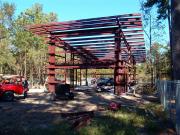Current
Practice, 2008: Many Voices
Cameron
Armstrong
CAA's open practice is highly conditioned by the worlds in which it operates. These writings are footnotes to current work in design and construction, and a snapshot of critical issues. It is also a work-in-progress, for update during the first half of the year. For background, see Architecture in Real Time, a description of how open practice in design emerged.
1. Technologies
The success of the electric arc furnace has meant that most steel used in U.S. metal buildings is now recycled. As a result, the debate about whether construction with wood or steel is most environmentally responsible has been resolved in favor of the prefabricated metal building type used in most CAA projects. Combined with the integrated decision-making among client, designer and engineer enabled by advanced architectural software and internet programs, this approach has helped us to envision larger photovoltaic and rain water harvest systems, and larger interior and exterior spaces, while reducing the time and cost of construction. We're presently exploring ways to apply these technologies to real time interaction between clients, designers, engineers and contractors.
Because of what and how our buildings are made, prefabrication continues to have a big impact on CAA. In the past, it implied remote factory completion of major elements, to be shipped for attachment to a site-built foundation. With advances in jobsite ergonomics, the focus of prefabrication shifted in the 1990's to delivering parts for quick assembly at the project address. Because of new tools and techniques, the shop floor of the factory now literally extends to the jobsite. To summarize: a prefabricated metal shell is quickly erected to provide a weatherproof envelope, and the building is rapidly completed within it. Instead of sending things like cabinets or stairs to a remote factory for attachment to a building fragment, later itself to be moved, they are sent directly to the project. Since the site is now a "factory" in its own right, the inefficiencies of separate production are eliminated. As a result, the modern kit-type prefab is many times cheaper and faster to construct than its ancestors, and its appearance is unconstrained by the modular disciplines of road and railway transit.
2. Subjectivities
One effect of trying to open design to all relevant interests has been to create new subjectivites. At times, it seems we've lent voice even to things without actual living presence, enabling them to speak for both tangible and tangible interests. When fleshed out in rich description, their testimony has sometimes played a dramatic role, rivalling their living, breathing counterparts. Results have been general, affecting all of our work, as well as particular. For example, because the quality and orientation of the wind was an important figure in numeorus hot-climate projects, we gained appreciation for buildings' aerodynamic ground effects. Perhaps it seems odd to "listen" to the wind, but virtually every design now shapes the building volume and its roofs, walls and openings to interact with prevailing breezes for aerodynamic effect. Another example is how the large roofs designed to shade clients from the South's hot sun confirmed our preference for steel structure, with its economical long spans. That in turn inspired a generalized approach to designing for photovoltaic and rain harvesting systems, which benefit from large, low-sloped expanses of metal roof. In seeking out such voices, we've become highly attuned to the conditions operating upon our sites, and to their expressive potential. Do these inanimate characters actually "speak"? Obviously not, but according respect by way of granting them a virtual presence during design brings us into closer relation with them. Ultimately, this critical listening pushes our designs, and the experience of our buildings, into deeper and more specific engagements with both the site environment and the particular requirements of the client.
3. Convergence
Parallels between architectural practice and other disciplines seem to pop up almost daily. Some affinities, such as with structural engineering, arise from obvious overlaps of interest and responsibility. Others are due to theoretical relevance or analogy, such as with linguistics or psychology. But recently, our work has often seemed not just to benefit from other professions' insights, but actually to inhabit their terrains, both practically and intellectually. The clearest example is Anthropology, whose field study procedures are echoed in what we call "open practice." The result of this particular resonance can extend beyond shared concerns with representation and authority to the nature of the product itself. For instance, our work is sometimes compared to autoethnography due to its similar focus on the subject's self-narration, often realized through collecting clients' quite personal expressions of desire for "translation" into three dimensional space. Certainly, since the work of architects in general largely grows out of such material, the process for designing buildings always has the potential to foreground the reflexive performances that define autoethography. CAA's choice to systematically rely on such information to define design parameters results in a type of building whose apparatus is often as explicitly "cultural" as it is physical. As part of a client's study of his or her own life, it might also be considered the ultimate report of a certain kind of anthropological study. Obviously, many of the kinds of questions that emerge while reaching for this outcome are unanswerable without resort to the foreign discipline which specializes in them: anthropology. Willingly or not, we building designers can find ourselves entering that field not only as observers, but as practitioners.
For architects, a convergence with Art can seem even more obvious, as seen in the prestige accorded to cultural commissions and the many hypothetical museums churned out annually in their schools. Clearly, artistic and architectural work often both rely on similar means for their effects: light, shadow, form, etc. But representing art is not the same as inhabiting artistic ground: lacking a purely symbolic dimension, architecture cannot be art. However, building designers do experience a convergence with artistic practice when their concerns focus on action rather than symbology -- when working with vision or the emotions in order to motivate the mind or body, or to unfold particular experiences. Therefore, such work also becomes subject to art's critical terms, especially when considering how a thing might act in producing a human response. What's true of the architect's relation to artistic practice must also be true regarding other disciplines: when by necessity we trespass in others' professional realms -- even unwittingly -- we also become subject to their ethical and professional standards.
The value of CAA's engagement with engineering, art, anthropology and other disciplines, lies in how knowledge of their practices increases the ability to create a new shelter directly from all the various conditions with which it will ultimately interact, as well as from the clients' stated purposes. Through study of others' methods we gain the capacity to address project requirements on their own terms. Ideally, our kit of tools can comprise any and all means by which a site's physical, ideological and functional situation can be understood. Therefore, in listening we share common ground with psychologists; in conversation, we follow the anthropologists; in spatializing emotion, we submit to artistic critique; and so on.
4. Histories
Clients bring numerous histories to a design project -- personal, cultural and political -- which can be very useful in indicating its proper sources and directions. But often, because buildings personify social alignments, the desire to narrate historical connections can overwhelm other important issues. Since the U.S. Civil War, historical revivals in architecture have arrived in a predictable pattern. By that time, middle class civilization had already indulged in fashions for Classical design (starting 1200 years after the originals), and Gothic (500 years after the fact). The 19th Century ultimately saw the return of Tudor (300 years afterwards), Jacobean (250 years) and Queen Anne (roughly 200 years later), as well as doubled returns in "neo" form (like Neo Classicism). The present fashion for Modern Period buildings (only 60 years after the movement's height) continues the tendency to revive established signifiers at ever less remove from the present. As communication technologies advance, we can expect even less time for consensus to emerge on architectural symbols, with the result that period-focused architects will progressively mine more and more recent history.
But what happens when their focus moves to a few years or even months ago, rather than decades? The convergence of past and present will offer a candy-store abundance of viable revivals, in addition to the Modern, Classical, Colonial, and other common periods. But it's also likely that a semantic exhaustion may set in, similar to Houston's of the early 1990's. In those years, designers' focus suddenly (though temporarily) became contemporary, as they addressed those "other important issues:" fundamental matters of utility and purpose. As a result, new materials, techniques and building types were proven. And, the city's first "green" buildings were constructed, along with contrasting structures demonstrating a new priority for overtly political symbolism. Likewise, with the convergence of revivalism and the present, we may be on the brink of exciting new inventions, and new solutions to old problems. The nature of contemporary design may soon become a persistent question, and an open possibility.

